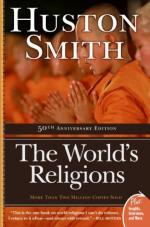|
This section contains 473 words (approx. 2 pages at 400 words per page) |

|
The World's Religions Summary & Study Guide Description
The World's Religions Summary & Study Guide includes comprehensive information and analysis to help you understand the book. This study guide contains the following sections:
This detailed literature summary also contains Topics for Discussion and a Free Quiz on The World's Religions by Huston Smith.
The World's Religions can best be described by taking note of what it is not. Author Huston Smith states emphatically that the book is not one of comparative religions. It is as objective a look as possible at the major religions of the world today for the purpose of enlightening people of different cultures and beliefs about each other. In this respect, Dr. Smith has achieved his aim.
In The World's Religions, Huston Smith has limited his focus to seven more or less organized world religions (Hinduism, Buddhism, Confucianism, Taoism, Islam, Judaism, and Christianity) with one chapter on Primal Religion. Under these broad headings, where necessary, Dr. Smith examines large sects within each main category. The book is not written in the standard textbook mode but rather is geared toward the general reading public, which makes the work extremely readable.
The chapter on Hinduism is the longest in the book, in part because of the various faces of Hinduism, primarily in India. Insofar as it is possible for a western writer, Smith manages to make it read from an Indian point of view. He is more successful at that with Hinduism and Buddhism than he is with other Asian religions. The Hinduism chapter is followed by the one on Buddhism, which first goes into some depth on the life of Siddhartha Gautama, the founder. It is almost impossible to separate the religion from the life of the Buddha, especially so because he did not intend to start a new religion.
The far eastern religions—Confucianism and Taoism—give insight into both the religions themselves as well as the cultures from which they sprang. As with Siddhartha, Dr. Smith spends a great deal of time on what is known about the life of Confucius before launching into a detailed study of the religion he left behind. Principles more than personalities are the focal points of these Asian religious treatments.
Islam, Judaism, and Christianity spring from the same well, so to speak, and are looked at more in terms of their agreements than in terms of their differences. The predominant character studies are of Moses, Jesus, and Mohammad. These three chapters manage to sidestep the areas of greatest contention among them.
Perhaps the most interesting chapter in the book is the one devoted to the Primal Religions, which are oral traditions that predate any organized religion in the world today. Smith is able to present the true values of these religions, which in earlier times were considered heathen. It is, in fact, from these primal religions that later, more organized religions sprang. The moral and familial codes of these religions are in many ways more strident than in later written creeds. In all, The World's Religions achieves its aim of broadening the view of divergent cultures and their religions.
Read more from the Study Guide
|
This section contains 473 words (approx. 2 pages at 400 words per page) |

|



